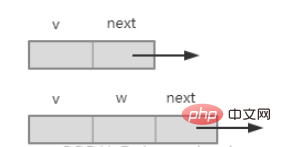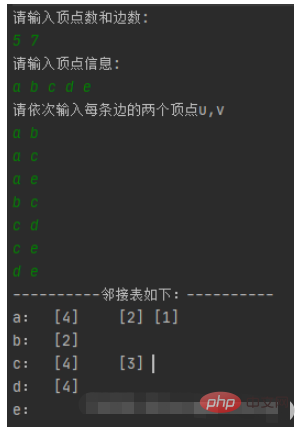How to use adjacency list to store graph in Java
1. The finishing touch
The adjacency list is a chain storage method for graphs. Its data structure consists of two parts: nodes and adjacency points.
Adjacency lists can be used to represent undirected graphs, directed graphs and networks. This is explained using an undirected graph.
1. Undirected graph

2. Linked table of undirected graph

3 .Explanation
The adjacent points of node a are nodes b and d, and the storage subscripts of their adjacent points are 1 and 3. Put them into the singly linked list behind node a according to the head interpolation method (reverse order).
The adjacent points of node b are nodes a, c, and d. The storage subscripts of their adjacent points are 0, 2, and 3. Put them into the singly linked list behind node b according to the head interpolation method (reverse order). middle.
The adjacent points of node c are nodes b and d, and the storage subscripts of their adjacent points are 1 and 3. They are put into the singly linked list behind node c according to the head insertion method (reverse order).
The adjacent points of node d are nodes a, b, and c. The storage subscripts of their adjacent points are 0, 1, and 2. They are put into the singly linked list behind node d according to the head interpolation method (reverse order). middle.
4. Undirected graph
The characteristics of the adjacency list are as follows. If there are n nodes and e edges in the undirected graph, then there are n nodes in the node table and 2e in the neighbor node table. nodes.
The degree of a node is the number of nodes in the singly linked list behind the node.
2. Data structure of adjacency list
1. Node
includes node information data and a pointer to the first adjacent point first.

2. Adjacency point
Includes the storage subscript v of the adjacent point and the pointer to the next adjacent point next, if it is an adjacent point of the network , then a weight domain w needs to be added, as shown in the figure below.

3. Algorithm steps
1 Enter the number of nodes and edges.
2 Enter the node information in turn, store it in the data field of the node array Vex[], and leave the Vex[] first field blank.
3 Enter the two nodes attached to each edge in turn. If it is a network, you also need to enter the weight of the edge.
If it is an undirected graph, enter a b, query nodes a, b, store the subscripts i, j in the node array Vex[], create a new adjacent point s, let s.v = j;s .next=null;Then insert node s before the first adjacent point of the i-th node (head interpolation method). In an undirected graph, there is an edge from node a to node b, and there is an edge from node b to node a, so a new adjacency point s2 needs to be created, let s2.v = i;s2.next=null; and then let The s2 node is inserted before the first adjacent point of the j-th node (head interpolation method).
If it is an undirected graph, enter a b, query nodes a, b, store the subscripts i, j in the node array Vex[], create a new adjacent point s, let s.v = j;s .next=null;Then insert node s before the first adjacent point of the i-th node (head interpolation method).
If it is an undirected network or a directed network, it is processed in the same way as an undirected graph or a directed graph, except that the neighboring nodes have an additional weight domain.
4. Implementation
package graph;
import java.util.Scanner;
public class CreateALGraph {
static final int MaxVnum = 100; // 顶点数最大值
public static void main(String[] args) {
ALGraph G = new ALGraph();
for (int i = 0; i < G.Vex.length; i++) {
G.Vex[i] = new VexNode();
}
CreateALGraph(G); // 创建有向图邻接表
printg(G); // 输出邻接表
}
static int locatevex(ALGraph G, char x) {
for (int i = 0; i < G.vexnum; i++) // 查找顶点信息的下标
if (x == G.Vex[i].data)
return i;
return -1; // 没找到
}
// 插入一条边
static void insertedge(ALGraph G, int i, int j) {
AdjNode s = new AdjNode();
s.v = j;
s.next = G.Vex[i].first;
G.Vex[i].first = s;
}
// 输出邻接表
static void printg(ALGraph G) {
System.out.println("----------邻接表如下:----------");
for (int i = 0; i < G.vexnum; i++) {
AdjNode t = G.Vex[i].first;
System.out.print(G.Vex[i].data + ": ");
while (t != null) {
System.out.print("[" + t.v + "]\t");
t = t.next;
}
System.out.println();
}
}
// 创建有向图邻接表
static void CreateALGraph(ALGraph G) {
int i, j;
char u, v;
System.out.println("请输入顶点数和边数:");
Scanner scanner = new Scanner(System.in);
G.vexnum = scanner.nextInt();
G.edgenum = scanner.nextInt();
System.out.println("请输入顶点信息:");
for (i = 0; i < G.vexnum; i++)//输入顶点信息,存入顶点信息数组
G.Vex[i].data = scanner.next().charAt(0);
for (i = 0; i < G.vexnum; i++)
G.Vex[i].first = null;
System.out.println("请依次输入每条边的两个顶点u,v");
while (G.edgenum-- > 0) {
u = scanner.next().charAt(0);
v = scanner.next().charAt(0);
i = locatevex(G, u); // 查找顶点 u 的存储下标
j = locatevex(G, v); // 查找顶点 v 的存储下标
if (i != -1 && j != -1)
insertedge(G, i, j);
else {
System.out.println("输入顶点信息错!请重新输入!");
G.edgenum++; // 本次输入不算
}
}
}
}
// 定义邻接点类型
class AdjNode {
int v; // 邻接点下标
AdjNode next; // 指向下一个邻接点
}
// 定义顶点类型
class VexNode {
char data; // VexType为顶点的数据类型,根据需要定义
AdjNode first; // 指向第一个邻接点
}
// 定义邻接表类型
class ALGraph {
VexNode Vex[] = new VexNode[CreateALGraph.MaxVnum];
int vexnum; // 顶点数
int edgenum; // 边数
}5. Test
White is output, green is input

The above is the detailed content of How to use adjacency list to store graph in Java. For more information, please follow other related articles on the PHP Chinese website!

Hot AI Tools

Undresser.AI Undress
AI-powered app for creating realistic nude photos

AI Clothes Remover
Online AI tool for removing clothes from photos.

Undress AI Tool
Undress images for free

Clothoff.io
AI clothes remover

AI Hentai Generator
Generate AI Hentai for free.

Hot Article

Hot Tools

Notepad++7.3.1
Easy-to-use and free code editor

SublimeText3 Chinese version
Chinese version, very easy to use

Zend Studio 13.0.1
Powerful PHP integrated development environment

Dreamweaver CS6
Visual web development tools

SublimeText3 Mac version
God-level code editing software (SublimeText3)

Hot Topics
 Square Root in Java
Aug 30, 2024 pm 04:26 PM
Square Root in Java
Aug 30, 2024 pm 04:26 PM
Guide to Square Root in Java. Here we discuss how Square Root works in Java with example and its code implementation respectively.
 Perfect Number in Java
Aug 30, 2024 pm 04:28 PM
Perfect Number in Java
Aug 30, 2024 pm 04:28 PM
Guide to Perfect Number in Java. Here we discuss the Definition, How to check Perfect number in Java?, examples with code implementation.
 Random Number Generator in Java
Aug 30, 2024 pm 04:27 PM
Random Number Generator in Java
Aug 30, 2024 pm 04:27 PM
Guide to Random Number Generator in Java. Here we discuss Functions in Java with examples and two different Generators with ther examples.
 Armstrong Number in Java
Aug 30, 2024 pm 04:26 PM
Armstrong Number in Java
Aug 30, 2024 pm 04:26 PM
Guide to the Armstrong Number in Java. Here we discuss an introduction to Armstrong's number in java along with some of the code.
 Weka in Java
Aug 30, 2024 pm 04:28 PM
Weka in Java
Aug 30, 2024 pm 04:28 PM
Guide to Weka in Java. Here we discuss the Introduction, how to use weka java, the type of platform, and advantages with examples.
 Smith Number in Java
Aug 30, 2024 pm 04:28 PM
Smith Number in Java
Aug 30, 2024 pm 04:28 PM
Guide to Smith Number in Java. Here we discuss the Definition, How to check smith number in Java? example with code implementation.
 Java Spring Interview Questions
Aug 30, 2024 pm 04:29 PM
Java Spring Interview Questions
Aug 30, 2024 pm 04:29 PM
In this article, we have kept the most asked Java Spring Interview Questions with their detailed answers. So that you can crack the interview.
 Break or return from Java 8 stream forEach?
Feb 07, 2025 pm 12:09 PM
Break or return from Java 8 stream forEach?
Feb 07, 2025 pm 12:09 PM
Java 8 introduces the Stream API, providing a powerful and expressive way to process data collections. However, a common question when using Stream is: How to break or return from a forEach operation? Traditional loops allow for early interruption or return, but Stream's forEach method does not directly support this method. This article will explain the reasons and explore alternative methods for implementing premature termination in Stream processing systems. Further reading: Java Stream API improvements Understand Stream forEach The forEach method is a terminal operation that performs one operation on each element in the Stream. Its design intention is






